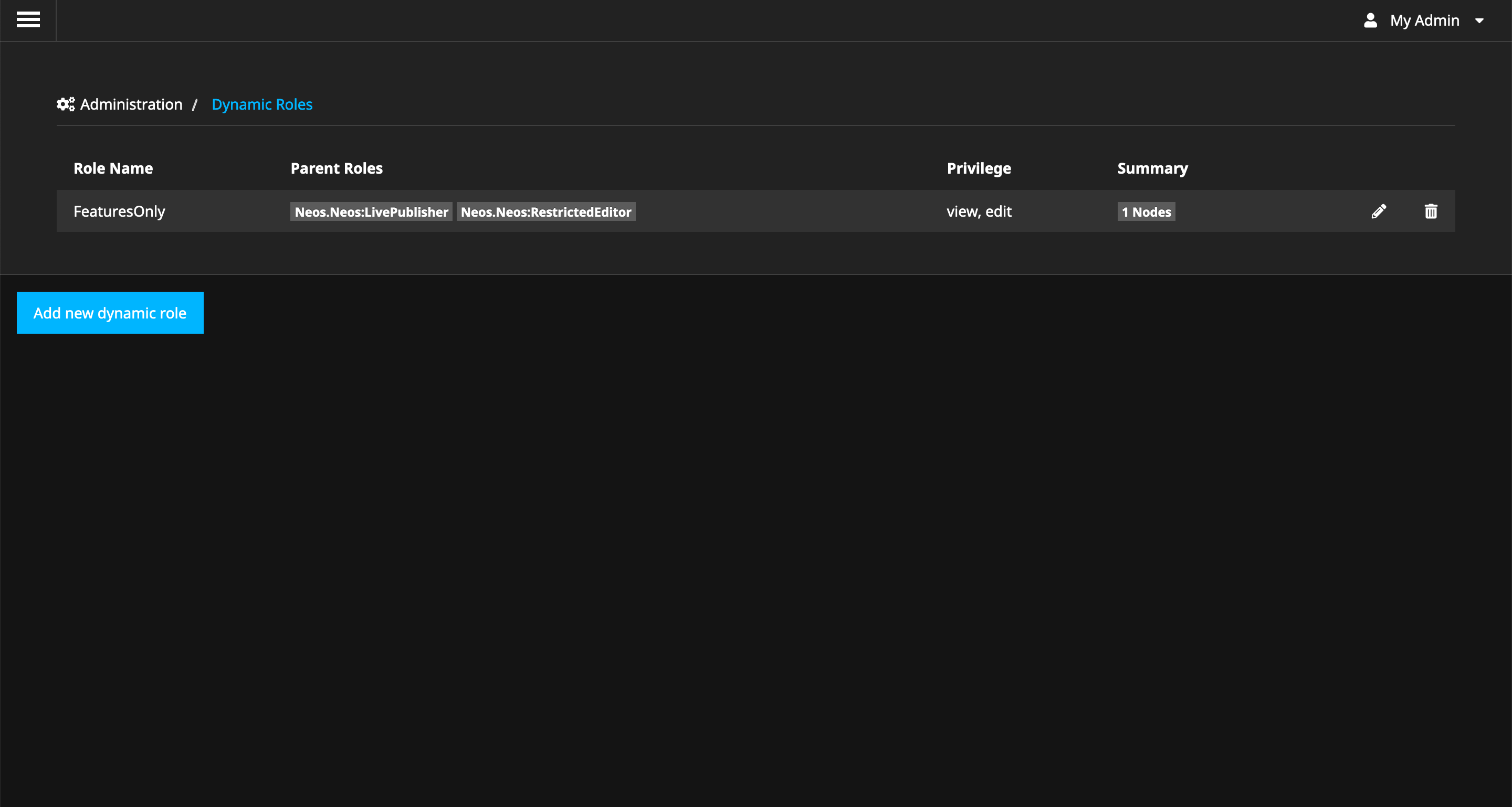sandstorm / neosacl
Installs: 53 607
Dependents: 0
Suggesters: 0
Security: 0
Stars: 14
Watchers: 10
Forks: 9
Open Issues: 10
Language:JavaScript
Type:neos-package
pkg:composer/sandstorm/neosacl
Requires
- neos/flow: ^7.0 || ^8.0 || dev-master
- neos/fusion-afx: *
This package is auto-updated.
Last update: 2025-12-10 13:00:56 UTC
README
This package implements dynamic Access Control Lists for Neos Roles.
The development of this package was sponsored by ujamii and queo.
Main features:
- Switch
RestrictedEditorto an allowlist-only permission approach. By installing this package, theRestrictedEditoris no longer allowed to change any content. - Configure dynamic roles through a Neos backend module.
- Permissions on the node tree, workspaces and dimensions possible.
- Permissions work predictably with sane defaults and purely additive logic.
Installation
- Install the package:
composer require sandstorm/neosacl
- Run the migrations
./flow doctrine:migrate
- Log in with an admin account and visit the new menu entry 'Dynamic Roles'
Development
Initial (Package) Setup
- Clone this package as
Sandstorm.NeosAclin the DistributionPackages of a Neos 4.3 or later installation - Add it to
composer.jsonas"sandstorm/neosacl": "*" - Run
composer update
Initial React Setup
cd Resources/Private/react-acl-editor
yarn
yarn dev
Then, log into the backend of Neos, and visit the module "Dynamic Roles".
Internal Implementation Details
Implementing Dynamic Node Privileges and MethodPrivileges
The basic idea was the following: Hook into PolicyService::emitConfigurationLoaded, and modify the $configuration array (introduce new roles
and privilegeTargets). This basically works at runtime - however there is a problem with dynamic MethodPrivilege enforcement, which is
explained below and by the following diagram:
How do Method Privileges work
- Background: An implementation of
PointcutFilterInterfacecan - during compile time of Flow - decide which classes and methods match for a certain aspect.- This is used in
PolicyEnforcementAspect(which is the central point for enforcing MethodPrivileges). - There, the
MethodPrivilegePointcutFilteris referenced. - The
MethodPrivilegePointcutFilterasks thePolicyServicefor all configuredMethodPrivileges - and ensures AOP proxies are built for these methods.
- This is used in
- Side Effect: Now, during building up the pointcut filters, the
MethodPrivilegePointcutFilteradditionally builds up a data structuremethodPermissions- which remembers whichMethodPrivilegesare registered for which method.- This data structure is stored persistently in the
Flow_Security_Authorization_Privilege_Methodcache. - At runtime, for a class which is intercepted by
PolicyEnforcementAspect, all configuredMethodPrivileges are invoked - and they have to quickly decide if they match this particular call-site. - This is done using the
methodPermissionsdata structure from theFlow_Security_Authorization_Privilege_Methodcache.
- This data structure is stored persistently in the
What's the problem with dynamically added MethodPrivileges
- If a
MethodPrivilegeis defined dynamically at runtime, then themethodPermissionsdata structure is missing the information that this new privilege should be invoked for certain methods. - NOTE: You can only dynamically add
MethodPrivilegesfor call-sites which are already instrumented by AOP; because otherwise the code will never get invoked (because of missing proxies).
We are mostly working with EditNodePrivilege etc. - so why does this apply there?
EditNodePrivilegehas an internalMethodPrivilegewhich takes care of the method call enforcement part; i.e. preventing you to call e.g.NodeInterface::setProperty()if you do not have the permission to do so.
Furthermore, to make this idea work, the Policy.yaml of this package defines a catch-all Sandstorm.NeosAcl:EditAllNodes
PrivilegeTarget - so AOP will instrument the corresponding methods of NodeInterface. This catch-all makes sense
in any case, because this switches the security framework to an allowlist-only approach
- making it easier to grasp.
The goal
In order to make the dynamic policy enforcement work, we need to add custom stuff to the methodPermissions - for
the dynamically added roles.
Implementation
The post-processing of the methodPermissions is done using a custom cache frontend (SecurityAuthorizationPrivilegeMethodCacheFrontend).
Implementing dynamic AOP Runtime Expressions
Method privileges internally can use dynamic AOP Runtime Expressions (in case you check for method parameters). Especially
the MethodPrivilege - which is attached to the RemoveNodePrivilege - uses the following expression code:
return 'within(' . NodeInterface::class . ') && method(.*->setRemoved(removed == true))';
The removed == true part is a so-called AOP Runtime Expression.
This is internally implemented using the Flow_Aop_RuntimeExpressions "cache", which is pre-filled again during the compile
time (which is a nasty side-effect).
Thus, in our case we need to again implement a custom cache frontend (AopRuntimeExpressionsCacheFrontend),
using the runtime expressions of the base configuration, which exists properly.


